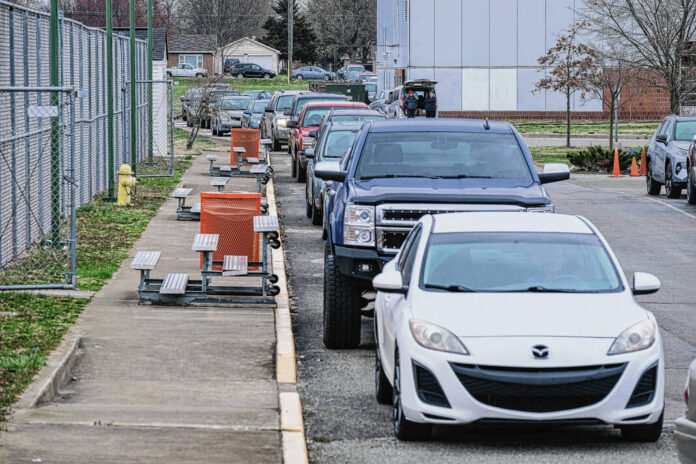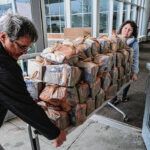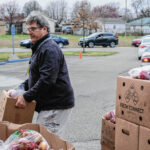
Mike Wolanin | The Republic Cars wait in line to pick up food from the Columbus East food pantry at Columbus East High School in Columbus, Ind., Friday, March 25, 2022.
As inflation continues to drive up prices for groceries, gas and housing, more and more Bartholomew County residents are turning to food banks to eat.
Currently, two local food banks — Love Chapel and Salvation Army — are seeing near record numbers of people seeking help with groceries, and officials fear that demand is going to further increase in the coming months.
Collectively, the two non-profits have served at least 5,700 people this month, which is the equivalent of about 1 in 13 Bartholomew County residents.
“We have seen a huge increase this calendar year,” said Kelly Daugherty, executive director of Love Chapel. “…It’s in the same ballpark as our highest (level of demand) ever.”
So far this year, Love Chapel has seen a 25% to 30% increase in demand compared to last year, Daugherty said. That amounts to about 4,800 people who are depending on the non-profit to eat.
Additionally, Love Chapel has seen higher-than-expected turnout at mobile food distributions in Elizabethtown and Taylorsville, where a collective 177 families received food last month, Daugherty said. Another 15 families turned out for an evening food distribution last month, including five new families.
Currently, the nonprofit is distributing 140,000 pounds of food per month, putting the organization on pace to give out 1.68 million pounds of food this year, up from nearly 1.4 million last year.
“Unless we see a drop in the inflation rate … I think it could get worse,” Daugherty said.
The situation is similar at Salvation Army, with levels of demand approaching all-time highs, officials said.
During the first 29 days of March, the organization served 902 people and is now seeing an average of five to 10 new families each week, including two new families within the first hour after opening on Tuesday, said Nancy Johnson, social services manager at Salvation Army.
“We have been picking up more new people since they cut back on the food stamps, and by now, people are probably out of their tax checks,” Johnson said.
The increase in demand at local food banks mirrors trends seen in other parts of the country as more people struggle to make ends meet amid the largest increase in inflation in decades.
Earlier this month, the federal government reported that consumer inflation jumped 7.9% over the past year, the sharpest spike since 1982 and likely only a harbinger of even higher prices to come, The Associated Press reported.
For most Americans, inflation is running far ahead of the pay raises that many have received in the past year, making it harder for them to afford necessities like food, gas and rent.
From January to February, nearly every category of goods and services got pricier. Grocery costs jumped 1.4%, the sharpest one-month increase since 1990, other than during a pandemic-induced price surge two years ago. The collective price of fruits and vegetables rose 2.3%, the largest monthly increase since 2010. Gas prices spiked 6.6%, clothing 0.7%.
For the 12 months ending in February, grocery prices leapt 8.6%, the biggest year-over-year increase since 1981, the government said. Gas prices are up a whopping 38%. And housing costs have risen 4.7%, the largest yearly jump since 1991.
At the same time, supply chain disruptions, lower inventory and labor shortages have all contributed to increased costs for charities on which thousands of Bartholomew County residents rely on for nutrition.
For its part, the Columbus East Food Pantry has seen “pretty steady” demand at its monthly community food distributions, with 203 families turning out for food this past Friday, said Greg Lewis, coordinator of the pantry and Bartholomew Consolidated School Corp. teacher.
The pantry plans to hold community food distributions in April and May but will then transition to focusing on students, which was the initial mission of the pantry, Lewis said. In an announcement about the April distribution, the pantry said, “there will be community food distributions on April 22nd and May 20th, but please note that the Columbus East Food Pantry community distributions will be coming to an end after the May 20th distribution.”
Lewis, who is retiring from teaching in May, said stopping the community distributions “is not a decision that we made lightly.” He hopes to develop a transition plan for other teachers to take over for him for the pantry once he retires.
However, the pantry has always struggled to attract students despite at least 30% of students at the high school being on free and reduced lunch, Lewis said.
Lewis suspects that a perceived stigma may be a barrier for some students who are experiencing food insecurity at home.
Data from Feeding America, a national network of over 200 food banks, is projecting that 13.3% of Bartholomew County residents — about 11,000 people — were food insecure last year, meaning that they lacked access to enough food for an active, healthy life.
“Food insecurity is a great concern,” Lewis said. “…I know the demand is going to remain high.“
Mike Wolanin | The Republic Volunteers distribute food from the Columbus East food pantry at Columbus East High School in Columbus, Ind., Friday, March 25, 2022.
Mike Wolanin | The Republic Chanda Welsh distributes food from the Columbus East food pantry at Columbus East High School in Columbus, Ind., Friday, March 25, 2022.
Mike Wolanin | The Republic Volunteers organize food for distribution from the Columbus East food pantry at Columbus East High School in Columbus, Ind., Friday, March 25, 2022.
Mike Wolanin | The Republic Greg Lewis, left, and Chanda Welsh organize food for distrubution from the Columbus East food pantry at Columbus East High School in Columbus, Ind., Friday, March 25, 2022.
Mike Wolanin | The Republic Kristin Beck helps organize food for distribution from the Columbus East food pantry at Columbus East High School in Columbus, Ind., Friday, March 25, 2022.
Mike Wolanin | The Republic Greg Lewis distributes food from the Columbus East food pantry at Columbus East High School in Columbus, Ind., Friday, March 25, 2022.
Mike Wolanin | The Republic Neil Smith, left, and Danielle Woolwine distribute food from the Columbus East food pantry at Columbus East High School in Columbus, Ind., Friday, March 25, 2022.
Mike Wolanin | The Republic Travis Anderson, with Columbus Animal Care Services, distributes pet food to cars in line for the Columbus East food pantry at Columbus East High School in Columbus, Ind., Friday, March 25, 2022.
Mike Wolanin | The Republic Cars wait in line to pick up food from the Columbus East food pantry at Columbus East High School in Columbus, Ind., Friday, March 25, 2022.













